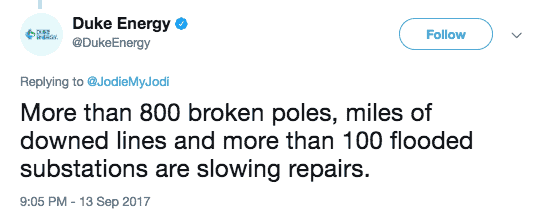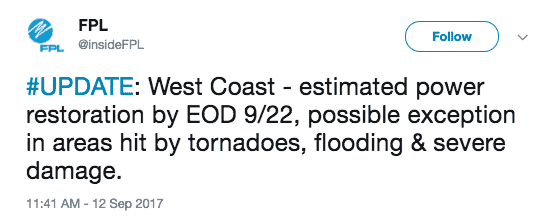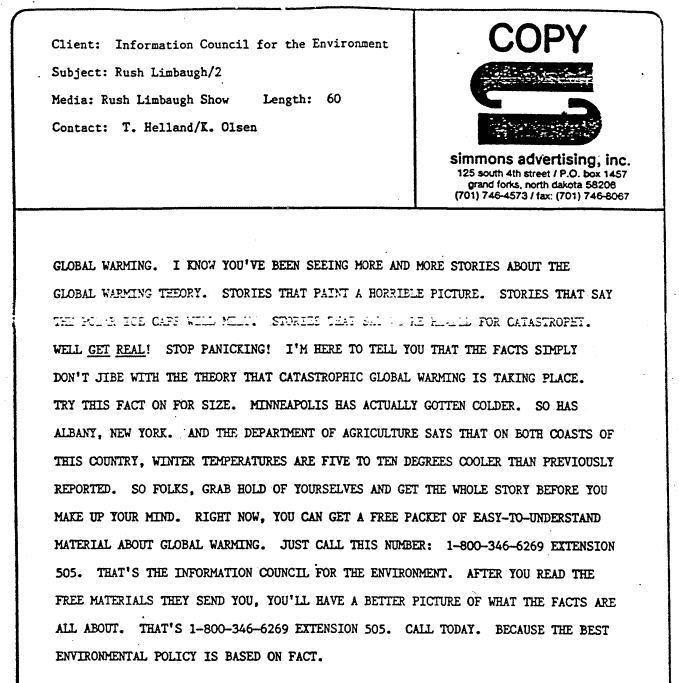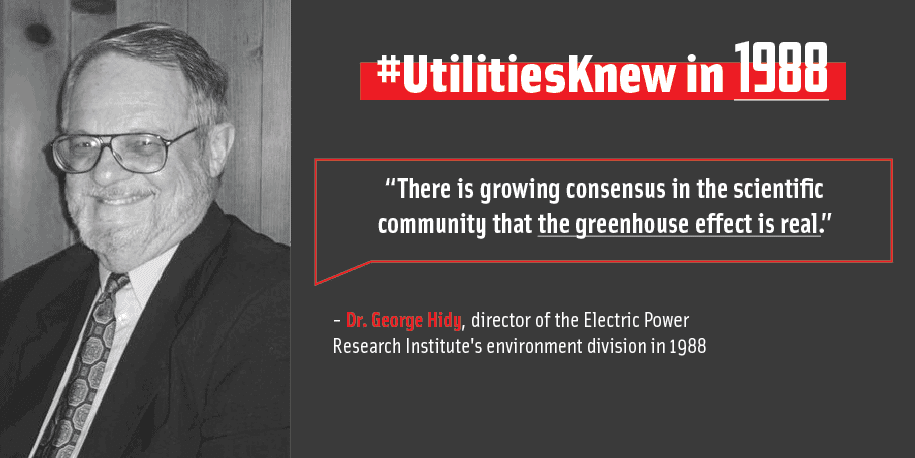A 1987 study sponsored by the electric utility industry warned that climate change could one day fuel more powerful storms, some thirty years before hurricanes Harvey and Irma. Despite this early knowledge, by 1989 some powerful utility interests had joined industry efforts to deny climate science and block legal limits on carbon dioxide emissions from their power plants.
Hurricanes Harvey and Irma have left millions in the South without electricity or air conditioning and left the sick and elderly exposed to the risks of heat illness in a year that could be among the hottest ever recorded. Fueled by climate change, these super storms hit major cities like Houston and Jacksonville with unprecedented storm surge and flooding. The records set by Harvey and Irma provide a stark reminder of why urgent action is needed to address climate change at a key moment when the Trump administration does not want to talk about climate change.

A NOOA/CIRA satellite image of Hurricane Irma off the cost of Florida
Three decades ago, a 1987 study co-sponsored by the electric utility industry did talk about the Potential Impacts of Climate Change on Electric Utilities. While the focus of this study was largely on how electric utilities in Florida and New York could prepare for increased demand for electricity caused by higher temperatures in 2015 (ironically by generating more power from coal and oil, fossil fuels that contribute to climate change, while wind and solar were left out of the analysis), the study also warned that:
… climate-related factors that influence electricity demand and utility operations not examined here include: humidity, winds, storm frequency and severity, and soil moisture (which may affect the demand for electricity for irrigation). Increasing atmospheric concentrations for greenhouse gases will likely influence these factors.
The study utilities backed in 1987 also recommended further research into the “significant impacts” climate change could have on utility operations through sea level rise and “extreme events”:
The case study analyses focused on the possible direct consequences of climate change on electricity demand and supply because of the attention these factors receive in long-term utility planning. However, climate change potentially could have significant impacts on other factors including the implications of:
… the indirect impacts of climate change for utility operations and planning (e.g., the potential impacts of sea level use on the siting and operation of generating units in coastal areas);
and changes in the occurrence of extreme events on utility system design and operations (e.g., the effects of more frequent or more severe storms on transmission and distribution system design and maintenance).
Florida Power & Light was a case study for climate change impacts on utilities in 1987
The 1987 study was one of scores of documents unearthed as part of the Energy and Policy Institute’s research for its recently released report, Utilities Knew: Documenting Electric Utilities’ Early Knowledge and Ongoing Deception on Climate Change From 1968-2017. Thirty years ago, the study by ICF Incorporated represented “…a first attempt at analyzing the potential impacts of climate change on individual electric utilities.”
It was jointly sponsored by the Edison Electric Institute (EEI), Electric Power Research Institute (EPRI), Environmental Protection Agency (EPA), and New York State Energy Research and Development Authority (NYSERDA). The analysis involved case studies of Florida Power & Light (FPL), according to a 1986 preview of the research project in the EPRI Journal, and utilities in New York. However, when the study was first published by NYSERDA in 1987, it made vague reference to a “Southeastern utility” and did not mention FPL by name.
According to the 1987 study, a rise in temperatures by 2015 would result in a “substantially larger percentage change in total energy consumption for the Southeastern utility,” due largely to the “importance of air conditioning in all seasons for that utility…” In 2017, hurricanes Harvey and Irma have left millions in the South without electricity and air conditioning, including many FPL customers. The storms have left many sick and elderly people exposed to the risks of heat illness in a year that could be among the hottest ever recorded.
“FPL has got to have a better plan for power,” the owner of an assisted living facility in Fort Lauderdale told the Associated Press in the wake of Irma.
The 1987 study also recommended that additional studies on the potential impacts of climate change on electric utilities be conducted at the individual, regional, and national levels to inform “policy development” and “utility planners and managers.” One of the study’s authors, Kenneth P. Linder of ICF Inc., presented the research at the the American Pollution Control Association’s 80th annual meeting as part of a panel that featured prominent climate scientist James Hansen and was led by Mark Miller of EPRI.
The EPRI Journal communicated similar recommendations and warnings to the electric utility industry. For example, a 1988 EPRI Journal article on The Politics of Climate included this passage (emphasis added):
Coastal development planning, for instance, should consider the possibility that a greenhouse-induced warming may raise the sea level a few inches to a few feet in the coming decades. According to Stephen Leatherman, director of the Laboratory for Coastal Research at the University of Maryland, the earth’s oceans have risen about six inches during the past century. As a consequence, 90 percent of U.S. beaches are eroding at a national average rate of slightly more than one foot per year, and many areas along the Atlantic and Gulf coasts are eroding three to five feet per year. Not only should roads and buildings be sited well back from eroding shorelines, claims Leatherman, but communities should recognize that even moderate rises in average sea level can allow destructive waves to reach much higher ground during severe storms.
Rising seas and other results of a global warming could have implications for utilities as well in areas ranging from plant siting to load profiles and the availability hydro resources. EPRI recently cofunded a study on possible impacts of climate change operations. Although such changes, if unanticipated, could be very costly to individual utilities, the study found that the costs could be significantly reduced with appropriate planning.
A summary of the 1987 climate change impacts study in another 1988 edition of the EPRI Journal included a list of “implications that climatic changes could have for utility planners.” Among them: “System reliability could be affected if climatic changes result in more-frequent and more-severe storms.”
Sure enough, in 2017, storm surge and extreme flooding caused by the climate change-fueled Harvey and Irma has challenged utilities ability to restore power to customers, despite their efforts before and after the storms.

A Tweet from Duke Energy

A Tweet from FPL
Utilities, including Southern Company and Tampa Bay Electric Company, funded climate misinformation after 1988
But after 1988, something changed. The electric utility industry was confronted by growing calls for action to address climate change by reducing carbon dioxide emissions. Some powerful utility interests would begin to engage in efforts to mislead the public and policymakers about the causes and risks of climate change in order to prevent legal limits on carbon dioxide emissions from power plants.
In 1991, EEI and Southern Company backed the Information Council on the Environment, a misleading ad campaign that was designed to “Reposition global warming as theory not fact.” Among the ads created for the campaign was this one for the Rush Limbaugh Show:

Limbaugh and Southern Company are still at it in 2017. Limbaugh maligned storm warnings ahead of Hurricane Irma on the air, but then himself evacuated from his Florida home as the storm neared. Hurricanes Harvey and Irma knocked out power to customers of Southern Company’s subsidiaries in Alabama, Florida, Georgia, and Mississippi.
In 2015, Southern Company was caught secretly funding the “climate misinformer” Dr. Wei-hock “Willie” Soon. Southern Company CEO Thomas Fanning denied that carbon dioxide emissions are a primary contributor to climate change during an March 2017 interview on CNBC. Later, at Southern Company’s 2017 annual meeting, Fanning misled his own company’s shareholders when he said:
“We choose, we have chosen over the years, to stay away from the rhetoric or the discussion on the science of climate change and a variety of other things, and rather say, ‘I want to figure out a way to deal with the emission of CO2.’”
The Tampa Electric Company (TECO) was one of the funders of the Global Climate Coalition, another industry group which worked from 1989 to 2001 to sow doubt about climate science and stop the U.S. from participating in the Kyoto Protocol, an international effort to address climate change. TECO even tried to make its customers reimburse the company for GCC membership dues.
EEI sponsored and published the work of climate skeptic Patrick Michaels during the 1990s. One 1993 article by Michaels published in EEI’s Electric Perspectives disputed what he called “… a vision of catastrophic global warming that ultimately leads to crop failures, rapid and inundating surges in sea level, enormous hurricanes, and burning forests incapable of renewing themselves.”
“It’s becoming warmer, yes, and perhaps will be warmer still, but to the degree of catastrophe?” Michaels said. “The available data on climatic change say no.”
The Miami New Times and Texas Observer have provided further examples of how individual utility companies in Florida and Texas have played role in perpetuating climate denial and/or failed to sufficiently clean up their own greenhouse gas emissions.

The electric utility industry knew there was a growing consensus on climate change in 1988, but some powerful utility interests have since engaged in a decades long campaign of denial.
What comes next?
Utilities like FPL have talked at length about their efforts to prepare for and respond to major hurricanes like Harvey and Irma, and so has EEI. Their linemen in particular deserve credit for their ongoing efforts to minimize power outages and restore power as quickly as possible.
But it’s also important to remember that the electric utility industry remains a top source of CO2 emissions, despite having been warned as far back as 1968 about the risks that burning fossil fuels could one day pose to the climate. While the electric utility industry did engage in some cutting edge climate research during the 1970s and 1980s, it still took nearly 20 years after 1968 for the first study of the potential impacts of climate change on electric utilities to appear. When that study finally arrived in 1987, it focused on steps utilities could take to increase profits – building new coal and oil generation and selling more electricity – as a way to prepare for climate change. By 1989, some powerful utility interests – including Southern Company and EEI – had joined with the fossil fuel industry to attack climate science and oppose legal limits on CO2 emissions – an effort that continues in some forms today. We now live with the legacy of climate denial, as carbon dioxide emissions to date have locked-in the risks of harmful levels of climate change and extreme storms.
Southern utilities now have a real opportunity to better plan for a future climate change as they rebuild from the climate change-fueled devastation wrought by hurricanes Harvey and Irma, just as they should have started to plan for a clean energy future decades ago when their own studies warned of the impacts from climate change and extreme storms.

